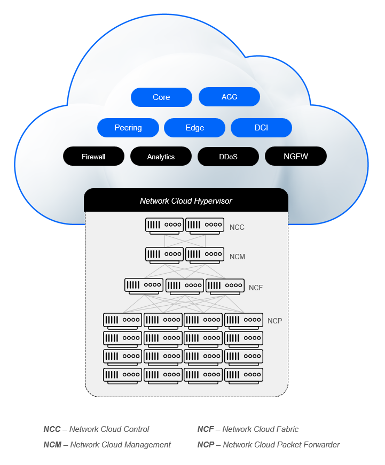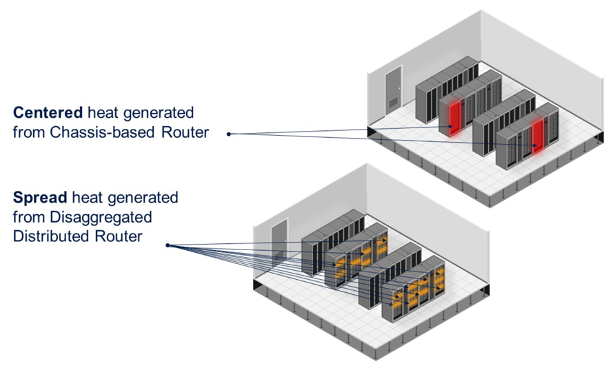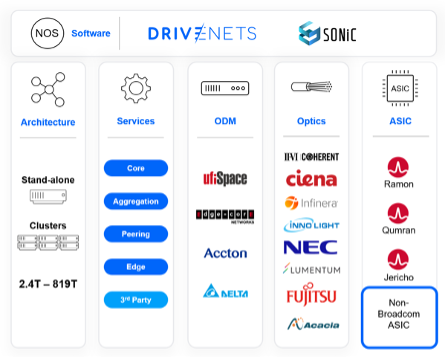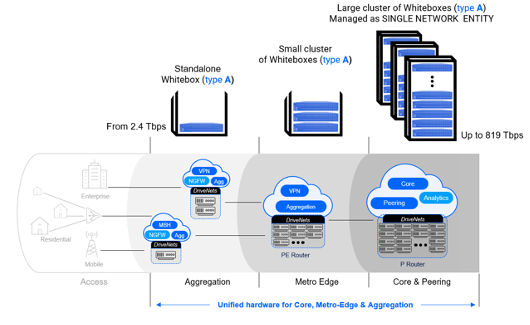All of this drives the physical port count and operational complexity of the IP aggregation network to support scale and resiliency.
The Distributed Disaggregated Chassis (DDC) architecture
The good news is that a new open architecture – the Distributed Disaggregated Chassis (DDC) – has been designed to solve most of the issues MSOs are facing right now with their IP aggregation and even more (e.g., core, -metro edge and aggregation). Defined by the OCP (Open Compute Project), DDC outlines an alternative to chassis-based routers, built on discrete, interoperable, multivendor components, that MSO operators can mix and match any ASIC, ODM, NOS, and optics to achieve an efficient routing system. The basic concepts of DDC include:
- Network processor-based, distributed high-capacity forwarding (the “packet unit” equivalent to the line card)
- Scalable control-plane functions – separated from user plane functions – often running on a general purpose x86 CPU (the “control unit” running protocol operations and maintaining system functions)
- Interconnection between elements using a deterministic fabric (the “fabric unit” cell-based, deterministic, and input-queued)
- Highly interoperable, standards-based optical connectivity
- Modern NOS (Network Operating System) software – like DriveNets Network Operating System (DNOS) – container- and microservice-based, which provides standard routing protocols, operational interfaces, and full lifecycle of each component (software is not part of the OCP specification per se)

Example of a DDC-compliant solution – DriveNets Network Cloud
These units can be used to build any router size with the same white box building blocks, offering multiple benefits for MSOs:
1. Reduce port count
Current MSO IP aggregation networks rely on a costly spine-leaf architecture. User ports are used to interconnect the different chassis (intra-site connectivity) – it’s common to see 30-40% of “sacrificed” user ports within the same hubs – reducing port density and increasing costs.
On the other hand, the DDC model uses a non-blocking, efficient architecture that can scale up to 819 Tbps with DriveNets Network Cloud, while drastically reducing the loss of Intra-PoP-traffic ports or removing them completely.
2. Overcome space and power constraints
DDC solutions are deployed in incremental scalability of multiple 2RU boxes. Each box has a specific function: packet forwarding, fabric or control. The small footprint gives physical flexibility for the space and power constraints that are typical for most data centers or hub locations.
In addition, DDC power consumption – the key concern in term of OpEx – is equivalent to its chassis counterpart, as legacy and ODM vendors typically have access to the same technologies and design partners, leading to similar power consumption needs.
DCC power distribution is a key advantage vis-à-vis its chassis equivalent. The DDC model overcomes per-rack power constraints of the chassis, and supports white box placement over multiple racks, since the elements are connected through cables instead of a chassis backplane. DDC gives flexibility in term of physical design within a hub/headend location and allows the “spread out” of power consumption over multiple racks.

3. Enable vendor choice
The DDC model offers cable MSOs the best-of-breed solutions, as vendors for hardware and software are certainly different among a growing vendor marketplace. Today, there are several ODM vendors supporting the DDC architecture (such as UfiSpace, Edgecore, Delta…), with different vendor options for optics or cables and a handful set of software vendors (DriveNets as the main player).
MSOs can certainly choose hardware from one vendor and software from another, each focusing on their own domain, thus driving a healthy competition and accelerating the pace of innovation versus integrated chassis solutions, where hardware and software must be developed together by a single, traditional vendor.

4. Simplify operations
While spine-leaf architectures are complex and costly systems to operate, DDC architectures can scale-out in a standardized and, more importantly, predictive way.
Initial NOS software load and configuration of the white boxes may look complex as the system scales (more boxes to manage), but a DDC solution includes a built-in orchestrator that automates ‘day zero’ and ‘day one’ operations, and orchestrates system capabilities, hence helping operational scale. This removes the operational overhead of managing multiple refresh cycles for line cards or system forklifting.
DDC systems look and operate nearly identically to legacy, chassis-based system once installed. They can operate as a virtual single entity through built-in system orchestrators and their maintenance and troubleshooting are even simpler with advanced automation and deeper component-based visibility.
5. Deploy production-ready solutions
Current DDC solutions with the right NOS have a 100% coverage of the technology needs, protocols, and use cases compared to existing chassis-based systems and designs. Aggregation routing typically does not require complex configuration or protocol support. Usually, only light-touch policies, traffic engineering, and coarse QoS enforcement are needed, but smart software engineering and expertise from production systems help achieve high system resiliency and availability.
Moreover, DDC solutions mainly focus on 100GE and 800GE interface types, which make them a good fit to aggregation network migration to 100GE ports.
Production of a DDC solution takes between 6 to 12 months, including hardware certification and testing. As the DDC hardware is the same across multiple network domains, once the hardware is validated, it is easy to expand the versatile DDC solution to peering, metro- edge or core use-cases with a much more reduced time-to-market.

DDC: The most beneficial option for building MSO’s IP aggregation networks
MSOs should evaluate white box-based DDC solutions as they deliver a strong alternative to traditional chassis-based systems (spine-leaf architecture) with:
- Efficient scale-out architecture
- Simplicity to operate
- Production-ready
With significant and positive impact on the design and architecture of the network, DDC and white-box solutions offer compelling, valuable alternatives for the future of networks.
For more information about DDC real life experience, and the operational impacts of supporting a disaggregated, distributed, cloud-based network architecture, we invite you to read the blog, recently published, based on Comcast Cable session in NANOG 87 about their experience with DDC.
Related content for Multiple Service Operators (MSO)/Cable Operators
White Paper
Which Network Architecture Is Right for You




